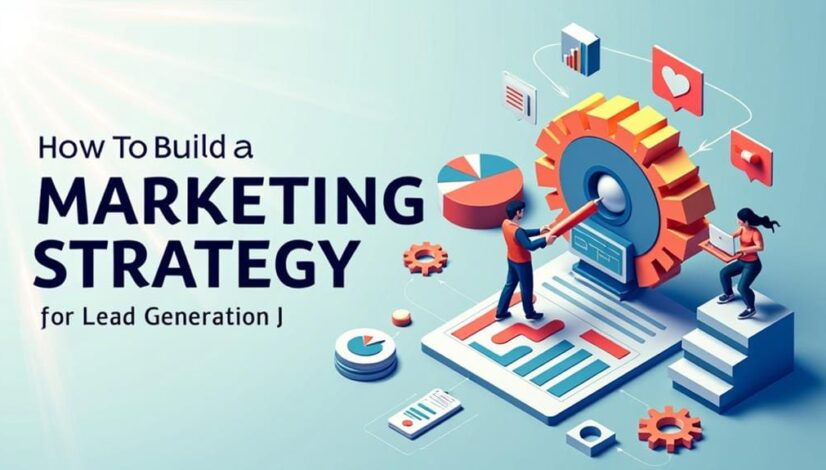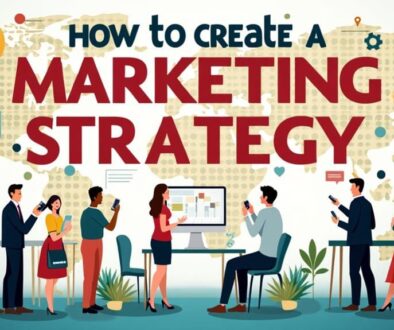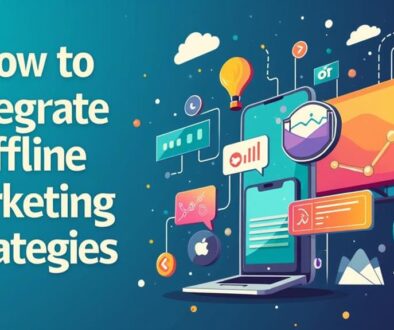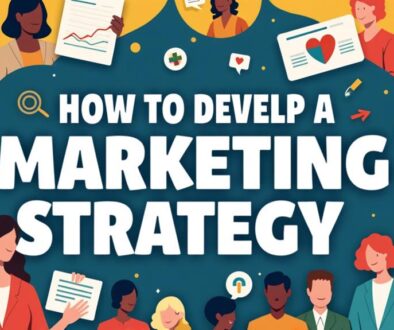How to Build a Marketing Strategy for Lead Generation
To build an effective marketing strategy for lead generation, begin by defining your target audience through demographic and psychographic analysis. Set clear marketing goals, ensuring they are measurable to track success. Analyze competitor strategies to identify market gaps and unique value propositions. Develop key messaging that resonates with your audience and choose the right channels for distribution, including social media and email marketing. Implement lead capture techniques such as optimized landing pages and engaging content. Finally, measure results continuously to refine approaches, fostering an adaptable strategy poised for growth. Additional insights await to enhance your lead generation efforts.
Key Takeaways
- Define your target audience through demographic and psychographic analysis for tailored messaging that resonates with their aspirations.
- Set clear marketing goals with quantifiable metrics to drive qualified leads into the sales funnel effectively.
- Analyze competitor strategies to identify market opportunities and unique value propositions for differentiation.
- Create diverse, engaging content that addresses audience needs and utilizes storytelling for emotional connections and brand loyalty.
- Implement lead capture techniques like optimized landing pages and lead magnets to incentivize information sharing from potential leads.
Define Your Target Audience
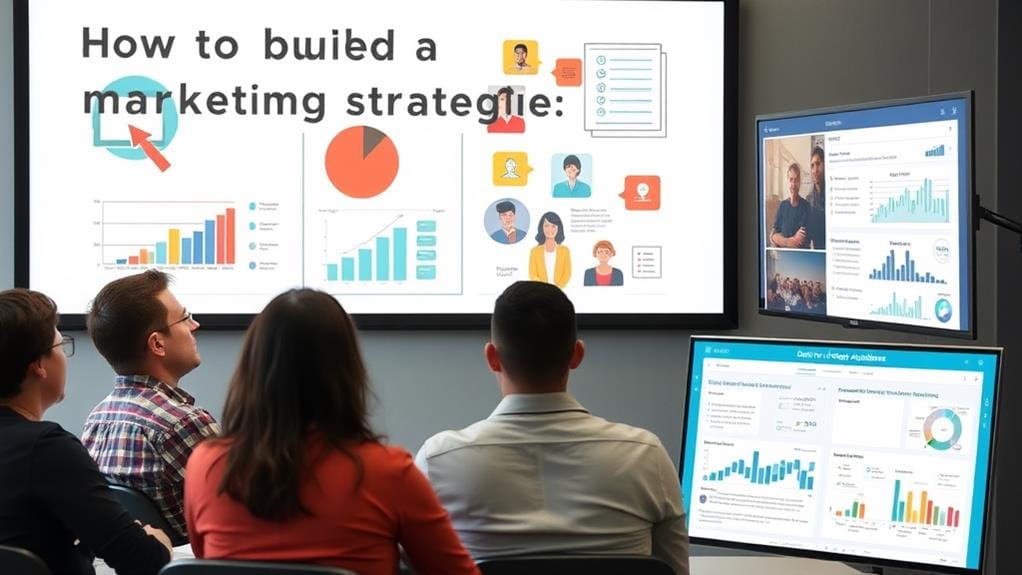
To effectively drive lead generation efforts, it is imperative to first define your target audience with precision and insight. This process begins with a thorough demographic analysis, where key characteristics such as age, gender, income level, and geographical location are meticulously evaluated. Understanding these components enables marketers to segment their audience effectively, ensuring that campaigns resonate with those most likely to convert.
Beyond demographics, psychographic profiling plays an essential role in enriching lead generation strategies. This approach investigates deeper into the values, interests, and lifestyles of potential customers, allowing for a more nuanced understanding of their motivations and desires. Recognizing the psychological drivers behind consumer behavior fosters the development of compelling narratives that speak directly to your audience's aspirations for freedom and autonomy.
Integrating findings from both demographic analysis and psychographic profiling empowers marketers to tailor their messaging and refine product offerings. By aligning marketing initiatives with the intrinsic desires of the target audience, organizations can articulate benefits that resonate on a personal level.
Additionally, such precision not only enhances lead quality but also optimizes resource allocation for marketing spend, maximizing overall ROI.
Set Clear Marketing Goals
Setting clear marketing goals is essential for effective lead generation, as these objectives provide direction and focus for your campaigns.
By defining your target audience, you not only create tailored messaging but can also establish quantifiable success metrics that measure performance and engagement.
This strategic approach enables businesses to optimize their marketing efforts and drive more qualified leads into the sales funnel.
Define Target Audience
Understanding your target audience is paramount to developing effective marketing strategies that drive lead generation. To connect authentically with potential customers, businesses must engage in thorough demographic profiling and psychographic segmentation.
Demographic profiling involves analyzing quantifiable traits such as age, gender, income, and education level, allowing marketers to identify broad segments of their audience. Meanwhile, psychographic segmentation digs deeper, examining values, beliefs, lifestyle choices, and behaviors that characterize their audience's motivations.
By combining these approaches, organizations can create a nuanced portrait of their ideal customers. This dual-layer understanding fosters targeted messaging that resonates with the audience's aspirations and pain points. For example, a brand geared towards health-conscious consumers might highlight product benefits that align with a wellness-oriented lifestyle, emphasizing freedom from sedentary habits.
Moreover, when marketing goals are aligned with a precise understanding of the target audience, the likelihood of engagement and conversion increases considerably. As a result, marketers who dedicate time to meticulously define their audiences through these techniques ultimately position their brands for sustained lead generation success, empowering them to forge long-lasting connections built on shared values and mutual understanding.
Measure Success Metrics
Establishing clear marketing goals is essential for measuring success metrics effectively, as it provides a framework that guides strategic decision-making and resource allocation. By defining specific objectives, businesses can assess their performance with quantifiable data, leading to improved outcomes in lead generation.
Key performance indicators (KPIs) such as lead scoring and conversion rates become fundamental in this context. Lead scoring allows organizations to prioritize leads based on their potential value, optimizing sales efforts and enhancing overall efficiency.
High conversion rates not only reflect the effectiveness of marketing campaigns, but also offer insights into customer behavior and preferences.
A data-driven approach to analyzing these metrics is imperative. Regularly reviewing lead scoring will help in adjusting outreach strategies, ensuring that resources are focused on high-potential leads.
Similarly, tracking conversion rates over time reveals trends and patterns that inform future marketing efforts.
Analyze Competitor Strategies

A thorough analysis of competitor strategies is essential for identifying opportunities and threats within a market landscape. By conducting an effective competitor analysis, businesses can derive strategic insights that enhance their lead generation initiatives.
Understanding how your competitors position themselves and engage with their audiences allows you to capitalize on unmet needs and differentiate your brand.
To structure your analysis effectively, consider focusing on the following key areas:
- Target Audience Engagement: Examine how competitors make contact with their target demographics. What platforms do they utilize for engagement?
- Content Strategy: Evaluate the type of content they produce. Are they leveraging blogs, webinars, or social media campaigns, and how successfully are they doing so?
- Value Proposition: Identify what unique offerings set competitors apart. What guarantees, pricing structures, or additional services do they provide that might attract your potential leads?
Armed with these insights, businesses can adapt their lead generation strategies to not only meet but anticipate market demands.
Look for gaps in competitors' offerings, improve upon their weaknesses, and employ innovative approaches that resonate with your audience.
Leveraging competitor analysis not only cultivates a deeper understanding of the landscape but also serves as a powerful tool in creating differentiators that drive engagement and conversion.
In a business environment where freedom and creativity reign, making informed decisions based on strategic insights will lead to sustainable growth and success.
Develop Key Messaging
To effectively generate leads, it is essential to first understand your audience and their specific needs.
By defining a unique value proposition that resonates with potential customers, businesses can differentiate themselves in a crowded marketplace.
Crafting engaging content that aligns with these insights is vital for capturing attention and driving engagement in lead generation efforts.
Understand Your Audience
Understanding your audience is paramount in developing key messaging that resonates and drives engagement. By delving into the nuances of audience demographics and behavior, marketers can create tailored messages that not only appeal but also engage potential leads effectively.
To build an impactful messaging strategy, consider these essential components:
- Audience Demographics: Identify age, gender, location, and income levels to shape your communications.
- Audience Painpoints: Analyze the specific issues and challenges your audience faces to position your solutions effectively.
- Audience Preferences: Recognize the content formats and channels your audience favors to enhance engagement opportunities.
Implementing a robust audience segmentation strategy allows marketers to craft messages that not only address unique preferences but also strike at the core of audience painpoints.
Understanding which elements amplify audience engagement can pivot a marketing approach from generic to specific, fostering deeper relationships.
Define Unique Value Proposition
Defining a Unique Value Proposition (UVP) is essential for establishing a compelling marketing strategy that effectively communicates what sets your offerings apart from competitors. A well-crafted UVP leverages differentiation strategies that appeal to the desires of your target market, leading to increased engagement and conversion rates.
To develop a potent UVP, you must first analyze customer insights—understanding their pain points, aspirations, and preferences. Research reveals that companies with clearly defined UVPs are 60% more likely to attract and retain customers, underscoring the importance of articulating distinct benefits.
Your UVP should encapsulate how your product or service uniquely addresses customer needs, presenting a clear rationale for why they should choose you over others. This includes identifying the elements that differentiate your offerings—be it superior quality, innovative technology, or exceptional service—and framing these factors in a way that resonates with your audience's values and motivations.
Incorporating your UVP into your messaging creates a compelling narrative that connects with potential leads. Ultimately, a powerful UVP not only drives lead generation but also fosters customer loyalty, paving the way for sustained business growth.
Craft Engaging Content
While a well-defined Unique Value Proposition (UVP) lays the groundwork for your marketing strategy, the next critical step is crafting engaging content that embodies your key messaging. Effective content forms the bridge between your brand and your audience's desires and needs.
To achieve this, consider utilizing the following approaches:
- Diverse Content Formats: Incorporate various content formats such as blogs, videos, infographics, and podcasts to cater to different preferences and enhance engagement.
- Storytelling Techniques: Employ compelling storytelling techniques that resonate emotionally, allowing audiences to connect personally with your brand. This fosters loyalty and trust.
- Visual Elements: Utilize striking visual elements that complement your written content, making it more digestible and attractive. This aids in audience retention and strengthens your brand voice.
Moreover, establish content calendars to guarantee consistent delivery and employ SEO strategies for enhanced visibility.
Incorporating multimedia integration and interactive content further amplifies audience engagement, driving lead generation.
Ultimately, your key messaging should reflect your brand's essence while empowering your audience and sparking their desire for freedom. A well-thought-out content strategy paves the way for dynamic content distribution and impactful connections.
Choose the Right Channels

Selecting the most effective channels for lead generation is pivotal, as it directly influences the success of your marketing strategy. A well-chosen channel not only reaches your target audience but also resonates with them in a meaningful way.
Today's diverse landscape offers various options such as social media, content marketing, and paid advertising, each playing a unique role in lead generation.
Social media channels, for example, facilitate community engagement and can greatly enhance organic reach. By creating shareable content, brands can leverage the power of influencer partnerships to amplify their message. Data shows that audiences often trust recommendations from peers over traditional advertising, making these partnerships invaluable.
Moreover, incorporating video marketing into your strategy can lead to increased engagement and higher conversion rates. Research highlights that viewers are 64% more likely to purchase after watching a product video.
Event marketing remains an effective channel, offering personal interaction and opportunities for relationship building. Additionally, well-structured referral programs can harness existing customer networks to generate new leads, providing a cost-effective method that capitalizes on trust.
Equally important is the application of search optimization techniques to guarantee your content reaches potential leads searching for solutions online.
By balancing these channels strategically—aligning them with your audience's preferences and behaviors—you can create a robust marketing strategy that not only reaches leads but also converts them into customers.
Ultimately, a multi-channel approach is essential for maximizing your lead generation efforts.
Create Engaging Content
Engaging content serves as the backbone of any effective lead generation strategy, compelling potential customers to interact with your brand. To achieve high levels of audience engagement, you must leverage various content types that resonate with your target demographics. By integrating storytelling techniques, visual elements, and innovative formats, you can create emotionally appealing narratives that captivate your audience's attention and inspire action.
Consider these three key strategies when crafting your content:
- Utilize User Generated Content: Encourage your audience to share their experiences with your brand. This not only fosters community but also enhances credibility and trust, thereby facilitating organic word-of-mouth marketing.
- Incorporate Interactive Formats: Websites hosting quizzes, polls, and surveys can greatly increase engagement rates. These formats not only capture user interest but also provide valuable insights into their preferences, enabling tailored content distribution.
- Employ Strategic SEO Techniques: A well-researched SEO strategy guarantees that your content reaches its intended audience. By optimizing your content for search engines, you increase its discoverability, ultimately driving more traffic to your site.
Moreover, don't underestimate the power of content repurposing. Transform existing materials into various formats—like infographics or podcasts—to reach different audience segments. This not only maximizes the value of your content but can also spread emotional appeal across varied platforms, facilitating more profound connections with potential customers.
Prioritizing these elements will position your brand as a thought leader and igniter of meaningful interactions.
Implement Lead Capture Techniques
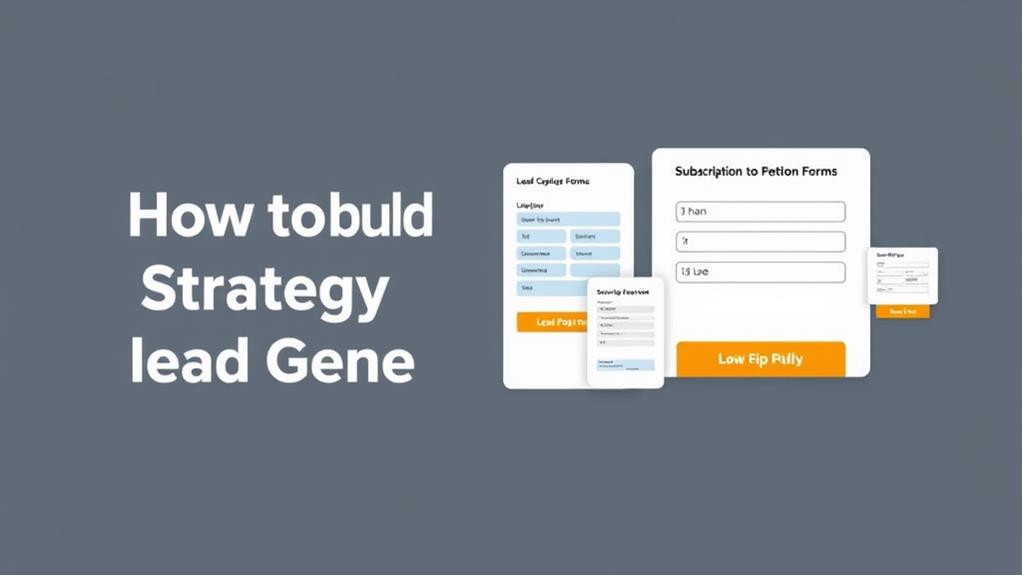
Effective lead capture techniques are vital for transforming website visitors into qualified leads, with studies indicating that organizations utilizing structured lead capture forms see conversion rates increase by up to 300%. To harness this potential, businesses must strategically implement lead magnets and landing pages that resonate with their target audience.
Lead magnets, such as exclusive eBooks, webinars, or free trials, serve as incentives for visitors to willingly provide their contact information. Aligning these magnets with the needs and challenges of your audience fosters a sense of value, overcoming hesitations regarding data submission. Data from HubSpot suggests that 80% of marketers who use lead magnets report better lead generation compared to those who do not.
Landing pages, on the other hand, play a significant role in the lead capture process. A well-optimized landing page focuses on a single call-to-action (CTA) that directs visitors toward converting. Utilizing A/B testing can further refine these pages, allowing marketers to discern what elements—such as headlines, visuals, and user testimonials—most effectively convert traffic into leads.
Incorporating persuasive copy that highlights the benefits of the lead magnet while maintaining a user-friendly design will guarantee higher engagement rates. Ultimately, the interplay between compelling lead magnets and optimized landing pages creates a seamless pathway for your audience to feel empowered and liberated in their decision to engage with your brand.
Nurture Leads Through Email
Nurturing leads through email marketing is a critical component of the overall lead generation strategy, enabling businesses to build trust and foster relationships with potential customers. It allows brands to communicate directly with leads, providing them with content tailored to their interests and needs.
To implement effective lead nurturing, reflect on the following strategies:
- Email Segmentation Strategies: Segment your email list based on user behavior, demographics, and preferences. This targeted approach guarantees that the content is relevant and increases engagement rates.
- Personalized Email Campaigns: Develop personalized email campaigns that reflect the individual interests of leads. Utilize data to create custom content, making recipients feel valued and understood.
- Automated Follow-Up Sequences: Establish automated follow-up sequences that guide leads through the sales funnel, utilizing lead nurturing timelines. For example, sending a series of informative emails over a set period can shift potential customers from awareness to contemplation.
Alongside these strategies, employing engagement tracking techniques allows you to assess the effectiveness of your campaigns.
A/B testing emails helps in subject line optimization and content variations to maximize open and click rates. Adhering to email design best practices is essential to maintain a professional appearance and guarantee readability.
Measure and Analyze Results

To guarantee the success of email marketing efforts and the overall lead generation strategy, measuring and analyzing results is essential. This process not only illuminates the effectiveness of your campaigns but also empowers you to make informed decisions that drive growth. Establishing robust performance tracking mechanisms allows for the concrete assessment of key metrics, such as open rates, click-through rates, and conversion rates.
Data visualization plays a critical role in this analysis, transforming raw numbers into comprehensible insights that facilitate strategic adjustments. By employing graphs, charts, and dashboards, marketers can quickly discern patterns and trends in lead behavior, enabling them to identify high-performing tactics and underperforming areas that require remediation. For instance, if a particular email format consistently results in lower engagement, the data provides a clear directive to explore alternative approaches.
Moreover, the continuous evaluation of data supports a cycle of constant improvement. As you gather information, adjust your strategies based on these insights and re-test different elements, reaffirming your commitment to freeing your marketing efforts from stagnation.
It is through rigorous performance tracking and insightful data visualization that marketers can uncover valuable opportunities for enhancement, ultimately empowering them to refine their lead generation approach. In a landscape where adaptability is paramount, an analytical and data-driven mindset becomes essential for achieving long-term success.
Embrace the numbers, adjust your strategy, and watch your leads flourish.
Optimize for Continuous Improvement
A robust approach to optimizing for continuous improvement is vital for maintaining the momentum of your lead generation efforts. By fostering a culture of iterative processes and stakeholder involvement, organizations can guarantee adaptability and resilience in a dynamic marketplace.
Emphasizing feedback loops and data-driven adjustments facilitates informed decision-making, allowing marketing teams to respond promptly to evolving circumstances.
To successfully implement a strategy for continuous improvement, consider these three essential components:
- Performance Reviews: Conduct regular assessments to gauge the effectiveness of your campaigns. Utilize key performance indicators (KPIs) to identify strengths and weaknesses, enabling agile marketing practices to flourish.
- Continuous Education: Invest in training and development to empower your team with the latest industry knowledge. This fosters a mindset open to strategic pivots, which can be vital for staying ahead of market trends.
- Feedback Loops: Establish mechanisms for gathering input from customers and stakeholders alike. This two-way communication nurtures a more profound understanding of client needs, driving adjustments that reflect actual market demands.
Frequently Asked Questions
What Budget Should I Allocate for Lead Generation Initiatives?
Determining an appropriate budget allocation for lead generation initiatives necessitates a careful analysis of marketing expenses and potential return on investment. A common approach is to allocate 5-10% of projected revenue towards these efforts.
However, businesses should evaluate past performance, industry benchmarks, and growth objectives to tailor their budget accurately. By investing strategically, organizations can enhance their lead acquisition capabilities, ultimately driving sustainable growth and achieving desired market freedom.
How Do I Know if My Lead Generation Strategy Is Working?
To assess the effectiveness of your lead generation strategy, analyze conversion metrics; studies show that 73% of leads are not sales-ready, emphasizing the importance of lead quality.
Tracking the ratio of qualified leads to total leads can reveal areas needing improvement. Additionally, monitor engagement rates and follow-up success, as these insights will inform your strategy's performance.
A data-driven approach enables you to optimize efforts, fostering greater freedom in achieving business objectives.
What Tools Are Essential for Lead Generation Tracking and Management?
Effective lead generation tracking and management demand essential tools such as robust Customer Relationship Management (CRM) systems to streamline data processing and enhance lead scoring methodologies.
Utilizing platforms that integrate seamlessly with existing CRM solutions allows for quantitative analysis of leads' behavior and engagement.
How Often Should I Update My Lead Generation Strategy?
Updating your lead generation strategy is akin to tending a garden; neglect may lead to stagnation.
It is advisable to reassess your approach quarterly, ensuring that your methods for lead nurturing and audience segmentation remain responsive to market dynamics.
By analyzing performance data and audience feedback, you cultivate a responsive strategy that thrives.
Regular updates empower a transformative approach, enhancing your potential for engagement and conversion in a constantly evolving landscape.
Can I Use Social Media for Lead Generation Effectively?
Utilizing social media platforms for lead generation can be highly effective, particularly due to their capacity for audience engagement.
By strategically crafting content that resonates with target demographics, businesses can foster meaningful interactions that convert potential leads.
Data indicates that companies leveraging social media generate more than 50% of their leads through these channels.
Consequently, integrating social media into marketing efforts not only enhances visibility but also cultivates connections that can lead to sustainable growth.
Conclusion
In the intricate tapestry of marketing strategy, lead generation emerges as a crucial thread interwoven with intentionality and analysis. By precisely defining the target audience and deftly choosing the right channels, organizations can capture attention and foster engagement. The continuous cycle of nurturing leads through personalized communication forms a robust foundation for conversion. Ultimately, the iterative process of measurement and optimization transforms raw data into actionable insights, driving success in an ever-evolving marketplace.
